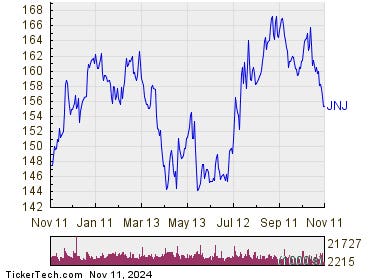Legendary investor Warren Buffett has famously advised investors to “be fearful when others are greedy, and be greedy when others are fearful.” This principle serves as a crucial guideline for navigating the stock market’s volatility, particularly in assessing the levels of fear and greed that can dictate investment decisions. One method to gauge the level of fear in trading is the Relative Strength Index (RSI), a technical analysis tool that measures a stock’s momentum on a scale from zero to 100. An RSI reading below 30 typically indicates that a stock may be oversold, suggesting a potential opportunity for investors to capitalize on lower prices.
Recently, shares of Johnson & Johnson (JNJ) hit a low RSI reading of 29.5 during trading, indicating that the stock has entered oversold territory. The share price fell to approximately $155.12. In contrast, the S&P 500 ETF (SPY) has a significantly higher RSI reading of 69.1, which reflects stronger bullish sentiment in the broader market. For investors who lean bullish, this low RSI reading for JNJ suggests that the heavy selling pressure may be subsiding, and it might signal a good entry point for buying into the stock as it could rebound.
Examining JNJ’s performance over the past year provides valuable context for assessing its current market position. The stock has fluctuated within a 52-week range, reaching a low of $143.13 per share and a high of $168.85. With the latest trade occurring around $155.40, the current price is noticeably above the lowest point for the year, but still reflects a substantial drop from its peak. This data emphasizes the potential opportunity presented by the current oversold condition, as a contrarian approach may suggest that the stock is undervalued amid broader market dynamics.
In addition to analyzing the RSI, investors may also consider other technical indicators and fundamental factors when evaluating JNJ and similar stocks that have entered oversold territory. Seeking fundamental strength, competitive advantages, and industry trends can provide a more comprehensive view of whether to invest in a given stock. Coupled with technical analysis, these factors can enhance decision-making processes and improve the likelihood of successful investing in turbulent markets.
Meanwhile, the concept of oversold stocks is broader than just JNJ. Many other stocks may also present similar opportunities as they experience significant price declines. It’s important for investors to identify these potential investments and conduct thorough analyses to ascertain their resilience and capacity for recovery in the future. Investors might benefit from developing a systematic approach to identify key performance indicators that signal when stocks are mispriced relative to their long-term value.
In conclusion, Warren Buffett’s advice serves as a timeless reminder for investors navigating the complexities of the stock market. The use of technical analysis, particularly the RSI, can aid in identifying oversold stocks like Johnson & Johnson, which may represent favorable buying opportunities amidst market fear. By taking a holistic approach that combines both technical and fundamental analyses, investors can enhance their understanding of market movements and position themselves strategically for potential gains when the market sentiment shifts.

